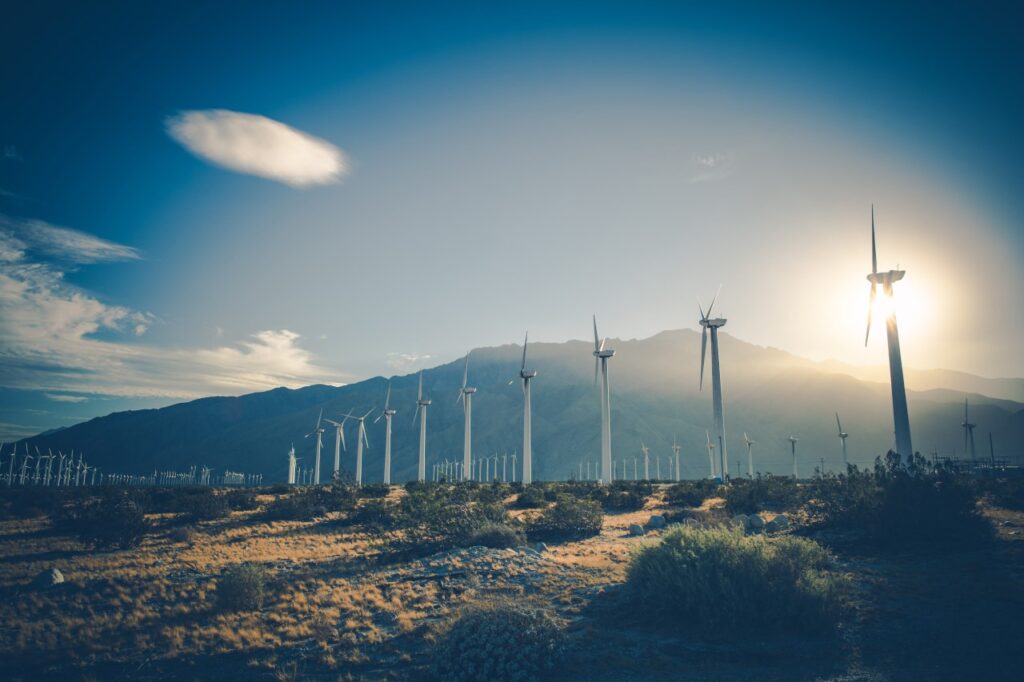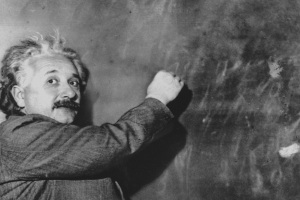Dieser Beitrag ist auch verfügbar auf:
Deutsch
Jeder Wandel in der Energiegewinnung hat Zivilisationen geprägt, technologische Durchbrüche ermöglicht und neue Herausforderungen geschaffen. Heute steht die Welt an der Schwelle einer neuen Ära: Saubere, erneuerbare Energiequellen und bahnbrechende Technologien versprechen, unsere Abhängigkeit von fossilen Brennstoffen zu beenden. Doch wie können wir diese große Herausforderung am besten bewältigen?
Biomasse als erste Energie-Behelfslösung der Menschheit
In den frühen Stadien der menschlichen Zivilisation war der Mensch hauptsächlich auf Biomasse wie Holz und andere pflanzliche Materialien angewiesen, die in offenen Feuerstellen verbrannt wurden. Diese Energiequellen waren für die Menschheit überlebenswichtig. Sie hatten jedoch einen geringen Wirkungsgrad und ihre Gewinnung war zeitaufwendig. Dies war insbesondere in Regionen mit zunehmender Bevölkerungsdichte und begrenzten Waldressourcen eine große Herausforderung.
Mit dem Wachstum der Siedlungen und dem Übergang von nomadischen Lebensweisen zu festen Agrargesellschaften nahm der Energiebedarf rapide zu. Die Menschheit begann, größere Mengen an Holz zu schlagen. In einigen Gebieten wie dem Nahen Osten oder dem Mittelmeerraum wurden Wälder nahezu vollständig gerodet. Dies ist ein frühes Beispiel für den Raubbau an natürlichen Ressourcen, das die Grenzen der damals verfügbaren Energiequellen aufzeigt.
Die Abhängigkeit von Biomasse als primärer Energieträger setzte auch der technologischen und gesellschaftlichen Entwicklung Grenzen. In urbanen Zentren wie dem antiken Rom stieg die Nachfrage nach Brennholz so stark an, dass es häufig aus weit entfernten Regionen importiert werden musste, was die Logistik und die Kosten in die Höhe trieb.
Im Mittelalter suchte der Mensch zuerst nach Ersatzstoffen
Im frühen Mittelalter begann man vereinzelt, Torf und Holzkohle als alternative Brennstoffe zu nutzen. Holzkohle, die durch Verschwelung von Holz in sauerstoffarmer Umgebung hergestellt wurde, hatte einen höheren Heizwert und brannte heißer als unbehandeltes Holz. Dadurch konnten höhere Temperaturen erreicht werden, was vor allem bei der Metallverarbeitung von Vorteil war. Trotz dieser Fortschritte war der Wirkungsgrad immer noch begrenzt und das Problem der Ressourcenknappheit blieb bestehen.
Das Bevölkerungswachstum und die Entwicklung der Landwirtschaft erhöhten den Druck auf die verfügbaren Ressourcen. Die unzureichende Energiebasis verlangsamte die gesellschaftliche Entwicklung und machte deutlich, dass neue Energiequellen benötigt wurden, um den steigenden Bedarf zu decken und den Übergang zu komplexeren Wirtschaftssystemen zu ermöglichen.
Dieser Bedarf an effizienteren und leichter zugänglichen Energiequellen legte den Grundstein für die spätere Nutzung fossiler Brennstoffe, die zur Grundlage der industriellen Revolution wurde.
Die Industrielle Revolution: Kohle als Motor des Fortschritts
Die industrielle Revolution im 18. und 19. Jahrhundert markierte einen Wendepunkt in der Geschichte der Energieerzeugung, zunächst in England, dann in ganz Westeuropa und in den USA. Die Entdeckung der Dampfkraft und der massive Einsatz von Kohle als Brennstoff ermöglichten eine bis dahin nicht gekannte Produktivitätssteigerung.
Kohle war reichlich vorhanden und hatte eine hohe Energiedichte. Sie wurde zur treibenden Kraft für die ersten industriellen Prozesse, den Eisenbahnbau und die Stahlproduktion. Die zunehmende Luftverschmutzung und die schlechten Arbeitsbedingungen in den Bergwerken waren jedoch deutliche Nachteile, die sich später als massive Umwelt- und Gesundheitsprobleme herausstellen sollten.
Das Zeitalter von Öl und Gas: Die Grundlage moderner Volkswirtschaften
Im 20. Jahrhundert verlagerte sich der Schwerpunkt der Energieerzeugung auf fossile Brennstoffe wie Erdöl und Erdgas. Diese Energieträger wiesen eine gute Transportfähigkeit, eine hohe Energiedichte und einen hohen Wirkungsgrad auf und wurden daher zunehmend bevorzugt. Sie ermöglichten die Verbreitung des Automobils, den Aufstieg der Luftfahrt und die weltweite Industrialisierung.
Das „Goldene Zeitalter des Erdöls“ förderte das Wirtschaftswachstum, veränderte geopolitische Machtstrukturen und führte zur Entstehung globaler Energiemärkte. Gleichzeitig war diese Phase aber auch geprägt von Umweltkrisen wie Ölkatastrophen und steigenden CO²-Emissionen, die zum Klimawandel beitrugen und die Grenzen der fossilen Energiewirtschaft aufzeigten.
Angeberwissen über frühe alternative Energien
Windmühlen als Vorläufer von Windkraftanlagen
Bereits im 7. Jahrhundert v. Chr. nutzten die alten Perser einfache Windmühlen zum Mahlen von Getreide. Diese frühe Nutzung von Windenergie war der Vorläufer moderner Windkraftanlagen.
Gezeitenkraftwerke als eine der frühsten Formen erneuerbarer Energien
Gezeitenkraftwerke beziehen ihre Energie aus der Erdrotation durch die Anziehungskraft von Mond und Sonne auf die Erde. Bereits im Mittelalter wurden diese zum Mahlen von Getreide eingesetzt.
In einem Gezeitenstaukraftwerk wird bei Flut Wasser hinter einem Damm aufgestaut und bei Ebbe durch Turbinen zurück ins Meer gelassen, wodurch Energie erzeugt wird. In einem Gezeitenspeicherkraftwerk wird das Wasser bei Flut hinter einem Damm gestaut und bei Ebbe durch Turbinen wieder ins Meer geleitet.
Wale als wichtige Energielieferanten im 19. Jahrhundert
Das aus dem Fettgewebe der Wale gewonnene Walöl wurde im 19. Jahrhundert als Brennstoff für Lampen verwendet und war für die Beleuchtung von Städten und Haushalten unentbehrlich. Der Rohstoff war so begehrt, dass einige Walarten kurz vor der Ausrottung standen. Erst mit der Entdeckung des Erdöls und der Entwicklung von Kerosin als Ersatz für Walöl ging diese Ära zu Ende. Kurioserweise löste die Suche nach einer neuen Energiequelle gleichzeitig eine große Umweltkrise und legte den Grundstein für eine neue.
Die Wende zu erneuerbaren Energien: eine neue Ära
Heute befindet sich die Welt inmitten einer neuen Energiewende, die durch den Klimawandel, den Rückgang fossiler Ressourcen und den technologischen Fortschritt beschleunigt wird. Erneuerbare Energien wie Windkraft, Solarenergie, Wasserkraft und Geothermie sind inzwischen zu tragenden Säulen der globalen Energieversorgung geworden.
Durch den technologischen Fortschritt sind die Kosten für erneuerbare Energien in den letzten Jahren dramatisch gesunken, was ihre Wettbewerbsfähigkeit gegenüber fossilen Brennstoffen stark erhöht hat. Der Ausbau erneuerbarer Energien wird oft als Schlüssel zur Dekarbonisierung der Wirtschaft gesehen und ist ein zentraler Bestandteil internationaler Klimaschutzabkommen wie dem Pariser Abkommen.
Das Pariser Klimaabkommen ist ein internationales Abkommen zur Bekämpfung des Klimawandels, das 2015 auf der UN-Klimakonferenz in Paris (COP21) von 196 Staaten verabschiedet wurde. Es trat 2016 in Kraft und hat zum Ziel, die globale Erwärmung auf deutlich unter 2 Grad Celsius gegenüber dem vorindustriellen Niveau zu begrenzen. Ideal wäre eine Begrenzung auf 1,5 Grad Celsius, um die schlimmsten Folgen des Klimawandels zu vermeiden.
Die nächste Stufe der Energiewende
Der Weg in die Zukunft wird maßgeblich von innovativen Technologien geprägt sein, die das Potenzial haben, unsere Energieerzeugung zu transformieren.
Effiziente Speicherung von Energie
Eine der größten Herausforderungen der erneuerbaren Energien ist ihre Abhängigkeit von Wetterbedingungen. Fortschritte in der Energiespeicherung, insbesondere durch moderne Batterien und stationäre Speichersysteme, ermöglichen eine Stabilisierung der Netze und eine zuverlässigere Versorgung, selbst wenn der Wind nicht weht oder die Sonne nicht scheint.
Wasserstofftechnologie
Grüner Wasserstoff, der mithilfe von Elektrolyse aus erneuerbarem Strom gewonnen wird, gilt als vielversprechender Energieträger der Zukunft. Er könnte fossile Brennstoffe in Schwerindustrien, im Transportwesen und in der Energiespeicherung ersetzen und somit zur Reduzierung von CO₂-Emissionen beitragen.
Smart Grids
Intelligente Energienetze, die durch digitale Technologien gesteuert werden, optimieren die Verteilung und den Verbrauch von Strom. Sie können Lastschwankungen ausgleichen und bieten eine höhere Effizienz sowie Flexibilität, indem sie Verbraucher, Erzeuger und Speicher miteinander vernetzen.
Das ION Power Grid integriert wesentliche Aspekte von Smart Grids wie dezentrale Energieerzeugung, Blockchain-basierte Transparenz und intelligente Netzsteuerung. Durch die mobile ION Power Station wird lokal erzeugte Energie direkt beim Verbraucher bereitgestellt.
Die Blockchain-Technologie ermöglicht eine transparente Abrechnung und automatisierten Peer-to-Peer-Energiehandel, während Smart Meter den Echtzeitverbrauch überwachen. Ergänzt wird diese Funktionsweise durch ein virtuelles Kraftwerk, das Schwankungen im Netz ausgleicht.
Der Weg zur Klimaneutralität ist eine der bisher größten globalen Herausforderungen
Die Bemühungen zur Dekarbonisierung der Energieerzeugung und der Übergang zu einer klimaneutralen Weltwirtschaft sind von entscheidender Bedeutung, um die Ziele des Pariser Klimaschutzabkommens zu erreichen.
Viele Länder und Unternehmen haben sich verpflichtet, bis Mitte des 21. Jahrhunderts klimaneutral zu werden. Dazu bedarf es umfangreicher Investitionen in Forschung und Entwicklung sowie einer Anpassung politischer Rahmenbedingungen, um den Wandel hin zu sauberen Energien zu beschleunigen.
Die zukünftige Energieerzeugung wird dezentraler, digitaler und nachhaltiger sein. Durch die Integration neuer Technologien und die Anpassung der Infrastrukturen kann ein resilienteres Energiesystem entstehen, das den wachsenden Energiebedarf der Menschheit deckt, ohne dabei die Umwelt zu zerstören. Die Vision einer grünen Energiezukunft ist zum Greifen nah – doch wir benötigen eine globale Zusammenarbeit, Innovationen und den Willen zur Veränderung, um sie Wirklichkeit werden zu lassen.






